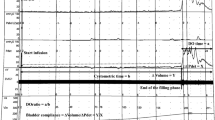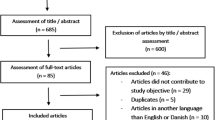Abstract
Study Design:
Retrospective chart review.
Objective:
To compare autonomic dysreflexia (AD) severity during urodynamics and cystoscopy in individuals with spinal cord injury (SCI).
Setting:
Outpatient urological clinic.
Methods:
Demographic and clinical data were collected from charts of individuals with SCI who had blood pressure (BP) monitoring during urological procedures. Cardiovascular parameters were collected at baseline and during the various stages of two examinations.
Results:
A total of 21 SCI individuals (mean age 49.4 years) who underwent both procedures developed episodes of AD. The majority of individuals had cervical SCI (85.7%). The median duration of injury was 183 months (ranging from 3 to 530 months). There was statistically more of an increase (P=0.039) in systolic BP during cystoscopy (67.1±33.8 mm Hg) in comparison with urodynamics (51.8±21.8 mm Hg). The BP response during episodes of AD was more pronounced in individuals with more than 2 years post SCI than with less than 2 years post SCI during both urodynamics and cystoscopy (P=0.047 and P=0.010, respectively).
Conclusion:
Even though cystoscopy filled the bladder to lesser volumes than did urodynamics (150 ml vs 500 ml), during cystoscopy the individuals developed greater changes in systolic BP, indicating that stimulation of the urethra/prostate/internal sphincter region probably is a more potent stimulus of AD than just the filling of the bladder. The severity of AD also increased with time post SCI during both procedures. Considering the high incidence of silent episodes of AD during the urological procedures, it is recommended that monitoring of cardiovascular parameters during these procedures be routinely performed.
Similar content being viewed by others
Log in or create a free account to read this content
Gain free access to this article, as well as selected content from this journal and more on nature.com
or
References
Teasell RW, Arnold JM, Krassioukov A, Delaney GA . Cardiovascular consequences of loss of supraspinal control of the sympathetic nervous system after spinal cord injury. Arch Phys Med Rehabil 2000; 81: 506–516.
Krassioukov A, Warburton DE, Teasell R, Eng JJ . A systematic review of the management of autonomic dysreflexia after spinal cord injury. Arch Phys Med Rehabil 2009; 90: 682–695.
Giannantoni A, Di Stasi SM, Scivoletto G, Mollo A, Silecchia A, Fuoco U et al. Autonomic dysreflexia during urodynamics. Spinal Cord 1998; 36: 756–760.
Linsenmeyer TA, Campagnolo DI, Chou IH . Silent autonomic dysreflexia during voiding in men with spinal cord injuries. J Urol 1996; 155: 519–522.
Curt A, Nitsche B, Rodic B, Schurch B, Dietz V . Assessment of autonomic dysreflexia in patients with spinal cord injury. J Neurol Neurosurg Psychiatry 1997; 62: 473–477.
Huang YH, Bih LI, Chen GD, Lin CC, Chen SL, Chen WW . Autonomic dysreflexia during urodynamic examinations in patients with suprasacral spinal cord injury. Arch Phys Med Rehabil 2011; 92: 1450–1454.
Vaidyanathan S, Watt JW, Soni BM, Krishnan KR . Intravenous salbutamol treatment for penile erection arising during cystoscopy of cervical spinal cord injury patients. Spinal Cord 1996; 34: 691–695.
Snow JC, Sideropoulos HP, Kripke BJ, Freed MM, Shah NK, Schlesinger RM . Autonomic hyperreflexia during cystoscopy in patients with high spinal cord injuries. Paraplegia 1978; 15: 327–332.
de Groat WC, Yoshimura N . Afferent nerve regulation of bladder function in health and disease. Handb Exp Pharmacol 2009; 194: 91–138.
Ho CP, Krassioukov AV . Autonomic dysreflexia and myocardial ischemia. Spinal Cord 2010; 48: 714–715.
Pan SL, Wang YH, Lin HL, Chang CW, Wu TY, Hsieh ET . Intracerebral hemorrhage secondary to autonomic dysreflexia in a young person with incomplete C8 tetraplegia: A case report. Arch Phys Med Rehabil 2005; 86: 591–593.
Eltorai I, Kim R, Vulpe M, Kasravi H, Ho W . Fatal cerebral hemorrhage due to autonomic dysreflexia in a tetraplegic patient: case report and review. Paraplegia 1992; 30: 355–360.
Kirshblum SC, Burns SP, Biering-Sorensen F, Donovan W, Graves DE, Jha A et al. International standards for neurological classification of spinal cord injury (revised 2011). J Spinal Cord Med 2011; 34: 535–546.
Krassioukov A, Biering-Sørensen F, Donovan W, Kennelly M, Kirshblum S, Krogh K et al. International standards to document remaining autonomic function after spinal cord injury. J Spinal Cord Med 2012; 35: 201–210.
Biering-Sørensen F, Craggs M, Kennelly M . International lower urinary tract function basic spinal cord injury data set. Spinal Cord 2008; 46: 325–330.
Biering-Sørensen F, Craggs M, Kennelly M . International urodynamic basic spinal cord injury data set. Spinal Cord 2008; 46: 513–516.
Wallin BG, Burton AR, Elam M, Tamaddon K, Millard R, Macefield VG . Viscerosympathetic reflexes in human spinal cord injury: relationships between detrusor pressure, blood pressure and skin blood flow during bladder distension. Exp Physiol 2013; 98: 1081–1091.
Ekland MB, Krassioukov AV, McBride KE, Elliott SL . Incidence of autonomic dysreflexia and silent autonomic dysreflexia in men with spinal cord injury undergoing sperm retrieval: implications for clinical practice. J Spinal Cord Med 2008; 31: 33–39.
Rivas DA . Chancellor MB. Flexible cystoscopy in spinal cord injury. Review article. Paraplegia 1994; 32: 454–462.
Cosman BC, Vu TT . Plowman BK. Topical lidocaine does not limit autonomic dysreflexia during anorectal procedures in spinal cord injury: a prospective, double-blind study. Int J Colorectal Dis 2002; 17: 104–108.
Cosman BC, Vu TT . Lidocaine anal block limits autonomic dysreflexia during anorectal procedures in spinal cord injury: a randomized, double-blind, placebo-controlled trial. Dis Colon Rectum 2005; 48: 1556–1561.
Krassioukov AV, Weaver LC . Episodic hypertension due to autonomic dysreflexia in acute and chronic spinal cord-injured rats. Am J Physiol 1995; 268: H2077–H2083.
Krassioukov AV, Weaver LC . Reflex and morphological changes in spinal preganglionic neurons after cord injury in rats. Clin Exp Hypertens 1995; 17: 361–373.
Ramer LM, van Stolk AP, Inskip JA, Ramer MS, Krassioukov AV . Plasticity of TRPV1-expressing sensory neurons mediating autonomic dysreflexia following spinal cord injury. Front Physiol 2012; 3: 257.
Acknowledgements
Dr Nan Liu is supported by a State scholarship from the China Scholarship Council to the Laboratory of Dr Krassioukov, International Collaboration on Research Discoveries (ICORD), University of British Columbia, Canada; Dr Andrei Krassioukov is supported by grants from the Canadian Heart and Stroke Foundation, Canadian Institute of Health Research, Canadian Foundation for Innovation, Rick Hansen Institute, Craig Neilsen Foundation and Christopher and Dana Reeve Foundation. We also acknowledge support from staff at the Blusson Spinal Cord Clinic during the preparation of this manuscript, Ms Teresa Lim and Ms Colleen McLean.
Author information
Authors and Affiliations
Corresponding author
Ethics declarations
Competing interests
The authors declare no conflict of interest.
Rights and permissions
About this article
Cite this article
Liu, N., Fougere, R., Zhou, MW. et al. Autonomic dysreflexia severity during urodynamics and cystoscopy in individuals with spinal cord injury. Spinal Cord 51, 863–867 (2013). https://doi.org/10.1038/sc.2013.113
Received:
Revised:
Accepted:
Published:
Issue date:
DOI: https://doi.org/10.1038/sc.2013.113
Keywords
This article is cited by
-
Autonomic dysreflexia in urological practice: pathophysiology, prevention and treatment considerations
World Journal of Urology (2024)
-
Guideline for the management of pre-, intra-, and postpartum care of women with a spinal cord injury
Spinal Cord (2020)
-
Prediction of autonomic dysreflexia during urodynamics: a prospective cohort study
BMC Medicine (2018)
-
International spinal cord injury urodynamic basic data set (version 2.0)
Spinal Cord Series and Cases (2018)
-
Current Management Strategies for Autonomic Dysreflexia
Current Bladder Dysfunction Reports (2018)



